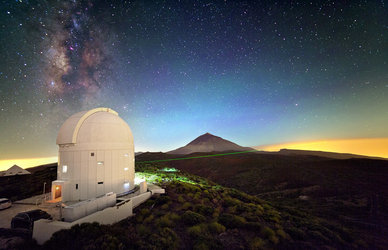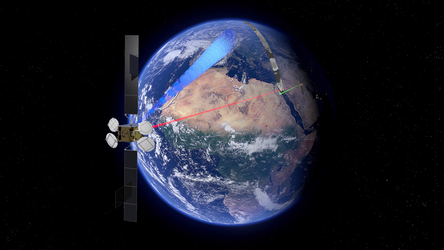AIMing a light across millions of kilometres
Imagine beaming a light across millions of kilometres of empty space, all the way back to Earth. ESA’s proposed Asteroid Impact Mission is intended to do just that: demonstrate laser communications across an unprecedented void.
The Asteroid Impact Mission, or AIM, undergoing detailed design ahead of a final go/no-go decision by ESA’s Ministerial Council in December 2016, is a deep-space technology-demonstration mission that would also be humanity’s first probe to a double asteroid.
Among its innovative technologies, laser communications would return results to scientists several times faster than standard radio signals.
“Optical communications in general is not yet a well-established technology for space and ESA’s European Data Relay System (EDRS) will be the first commercial application,” explains ESA optics engineer Zoran Sodnik.

“In principle it works something like Morse code, with encoded rapid flashes on and off. ERDS with satellites in high orbits will use laser links to return environmental data from Europe’s low-orbiting Sentinel satellites on a realtime basis, a technique previously demonstrated using ESA’s Alphasat and Artemis telecom missions.
“In 2013 ESA’s Optical Ground Station in Tenerife participated in a two-way contact with NASA’s LADEE lunar orbiter, across 400 000 km.
“But AIM will need to operate much further: we are benchmarking a maximum span of 75 million kilometres, or half the distance between Earth and the Sun. That might sound like a lot, but operating around Mars one day will involve much further distances still.”

A laser beam shone back from AIM’s 13.5 cm-diameter laser telescope at such a distance would have a ground footprint of about 1100 km – further than from London to Berlin. Also a lot but the equivalent radio beam radiating out across space would end up wider than our whole planet.
“The much higher frequency of laser light is what gives us higher directivity and as a result increased bandwidth,” adds ESA laser engineer Clemens Heese.
“At the same time, many photons will get lost on the way, so we need to use sophisticated photon counting methods to detect the signal reliably using our receiver telescope of around 1 m diameter.

“While radio communications is a very mature technology and close to optimum efficiency, there’s still lots of room for development with optical communications. So this is the way we need to go to really boost the quantity and speed of data we can deliver to scientists.”
To meet the challenge, ESA’s AIM team this month issued technology pre-development contracts to industry to tackle key issues including telescope design, detector electronics and coarse and fine-pointing systems. To give an idea of the kind of pointing required, AIM will need to align with the signal from Earth to within the diameter of planet Mars seen in our terrestrial sky.

“At 39.3 kg, AIM’s laser system will be one of the single largest payload items,” explains Andres Galvez, heading ESA’s Science Analysis and System Support Unit.
“We intend to gain maximum utility from it, by also using it for scientific purposes: the laser can also serve as an altimeter to chart the asteroid.”
The system design is led by RUAG Space in Switzerland, building on its existing family of Optel laser communication terminals, the latest of which is tailored for direct-to-Earth downlinks from minisatellites.















 Germany
Germany
 Austria
Austria
 Belgium
Belgium
 Denmark
Denmark
 Spain
Spain
 Estonia
Estonia
 Finland
Finland
 France
France
 Greece
Greece
 Hungary
Hungary
 Ireland
Ireland
 Italy
Italy
 Luxembourg
Luxembourg
 Norway
Norway
 The Netherlands
The Netherlands
 Poland
Poland
 Portugal
Portugal
 Czechia
Czechia
 Romania
Romania
 United Kingdom
United Kingdom
 Slovenia
Slovenia
 Sweden
Sweden
 Switzerland
Switzerland

































